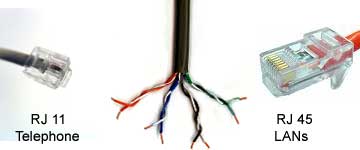![]() R. Craig Collins > Common
> Networking and LANs
R. Craig Collins > Common
> Networking and LANs
Networking and LANs © R. Craig Collins, 2005/6
You could compare a computer to a book. While it contains a lot of useful information,
a library would have even more information. Thus, if you could connect computers
to other computers, the increase in information would be dramatic. This is the
idea behind LANs, or Local Area Networks.
A collection of LANs is called a WAN, or Wide Area Network. The Internet is
a collection of WANs, for all practical purposes...)
There are several kinds of networks... Peer to Peer is where a regular computer
shares info with another regular computer. This bogs down though, if too many
computers get involved. For larger networks, typically something called a client-server
network is used.
A client-server network involves a special computer that like a waiter, serves
to you, the client, what you requested.
To allow the computers to communicate with each other they need the basics for
any communication: a sending device, a communication channel, and a receiving
device. Typically at home, the sending and receiving device are a modem, and
the communication channel is a telephone line. Many broadband users now tie
into the coax cable TV network.
In a business that has a LAN, the most common type of network is called Ethernet;
the sending and receiving device types are called a NIC (network interface card)
and the communication channel is what is called cat 5 (category 5) wire. Cat
5 is suitable for slower 10 Mb connections, or faster 100 Mb connections, which
are often referred to as 10Base T or 100BaseT.
The server and client wires normally connect to each other through a hub of
some sort, in a topology called a star. Other topologies include stars and bus
designs.

Dial up Phone line (Cat 3 Twisted Pair) uses RJ11 connectors
Ethernet network line (Cat 5 or Cat 6 Twisted Pair) uses RJ45
connectors

Coax (coaxial) cable and connector

Fiber Optic cable (normally many cables bundled) and FDDI
connector

Goal of networking:
1. Access control
a. Who can
i. Read
ii. Write
iii. Execute
iv. Create
v. Modify
vi. Delete
vii. List files
b. Access given to:
i. Individual User(owner of file)
ii. Group of users
iii. Others
2. Resources Control
a. Files
b. Printers
c. Etc.
3. Timeline
a. Set up network
i. Topologies
1. bus
2. star
3. ring
4. hybrid
ii. Connectivity
1. bridges
a. hubs, routers, switches
2. gateway devices
iii. protocols
1. IEEE
a. 802.3 Ethernet
i. 10/100 Mb
b. 802.11 b-g
i. 4-11-54 Mb
b. Set up server
i. Services
1. Domain Name Controller
2. Dynamic Host Configuration Protocol
3. Web
4. Mail
5. PDC vs. BDC
6. etc.
c. Set up groups
d. Set up users
i. When can they use resources
ii. What can they see and use
iii. Where can they access network
iv. How much storage and bandwidth should be allocated
e. Maintenance
f. Security
g. Limitations